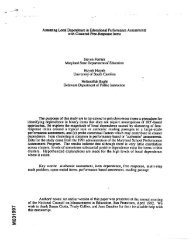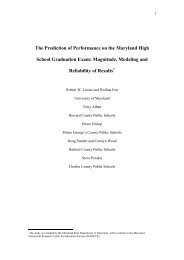A Brief Introduction to Evidence-Centered Design CSE Report 632 ...
A Brief Introduction to Evidence-Centered Design CSE Report 632 ...
A Brief Introduction to Evidence-Centered Design CSE Report 632 ...
Create successful ePaper yourself
Turn your PDF publications into a flip-book with our unique Google optimized e-Paper software.
ApplicationsBauer, M., Williamson, D.M., Steinberg, L.S., Mislevy, R.J., & Behrens, J.T. (April, 2001).How <strong>to</strong> create complex measurement models: A case study of principledassessment design. Paper presented at the annual meeting of the AmericanEducational Research Association, New Orleans, LA. [ECD design rationale fora simulation-based assessment of troubleshooting and design of computernetworks. Foundational analysis for the NetPASS on-line assessment ofnetworking skill, by the Cisco Learning Institute, Educational Testing Service,and the University of Maryland. Includes expert-novice analysis of problemsolving.]Cameron, C.A., Beemsterboer, P.L., Johnson, L.A., Mislevy, R.J., Steinberg, L.S., &Breyer, F.J. (1999). A cognitive task analysis for dental hygiene. Journal o fDental Education, 64, 333-351. [Expert-Novice study of expertise in problemsolvingin dental hygiene, with implications for assessment design.]Levy, R., & Mislevy, R.J. (2004). Specifying and Refining a Measurement Model for aSimulation-Based Assessment. <strong>CSE</strong> Technical <strong>Report</strong> 619. Los Angeles: TheNational Center for Research on Evaluation, Standards, Student Testing(CRESST), Center for the Study of Evaluation, UCLA.http://www.cse.ucla.edu/reports/R619.pdf. [Focus on estimation of conditionalprobability models in the Bayes net psychometric model in the Cisco LearningInstitute’s NetPASS simulation-based assessment of design, implementation,and troubleshooting in computer networks. A fairly technical psychometricpaper.]Mislevy, R.J., Almond, R.G., Dibello, L.V., Jenkins, F., Steinberg, L.S., Yan, D., &Senturk, D. (2002). Modeling conditional probabilities in complex educationalassessments. <strong>CSE</strong> Technical <strong>Report</strong> 580. Los Angeles: The National Center forResearch on Evaluation, Standards, Student Testing (CRESST), Center for theStudy of Evaluation, UCLA.http://www.cse.ucla.edu/CRESST/<strong>Report</strong>s/TR580.pdf. [Focus on estimation ofconditional probability models in the Bayes net psychometric model in theBiomass pro<strong>to</strong>type assessment. A fairly technical psychometric paper.]Mislevy, R.J., & Gi<strong>to</strong>mer, D.H. (1996). The role of probability-based inference in anintelligent tu<strong>to</strong>ring system. User-Modeling and User-Adapted Interaction, 5,253-282. Also available as <strong>CSE</strong> Technical <strong>Report</strong> 413. Los Angeles: The NationalCenter for Research on Evaluation, Standards, Student Testing (CRESST),Center for the Study of Evaluation, UCLA.http://www.cse.ucla.edu/CRESST/<strong>Report</strong>s/TECH413.PDF.[Good foundational explanation of the use of Bayesian inference in complexassessments, illustrated with the HYDRIVE intelligent tu<strong>to</strong>ring system fortroubleshooting aircraft hydraulics.]22






